Okay....I've been posting a bunch of picture essays of the changes I did to my stock '98 TJ. I don't have a lot of other posts so you can easily find those essays by looking in this subforum for my user name. The last chapter I posted showed the install of the rear dana 44 axle.
my rear dana 44 swap essay
The stuff below is part 4 and will show the work on the front end....and a few other things I had purchased parts for. This one is really long, even by my standards. My thanks to anyone who will take the time to read it.
---------------------
At this point in the story, I have the rear end of the jeep on the ground on the new 33 inch tires....the control arms are set roughly correct. But I haven't picked up the new rear driveshaft that I ordered at a local driveline shop. So I switched to the front of the jeep to work on that part. I put the frame on stands and pulled the tires. I have a dana high pinion 30 front axle assembly from a '99 XJ cherokee that will replace the factory front axle. There's more work in removing the front end than the rear. All the steering has to come loose. And I'm going to reuse the brakes so I'll go ahead and pull some of that stuff off while the axle is still bolted to the jeep frame.


I have a couple different common styles of automotive "pullers" to use on the front steering linkage. Usually you can knock tie rod ends loose with a few hammer blows on the steering knuckle. The shockwave will pop the tapered shanks free. Just don't beat on the thread ends. But to get started, I had to use a tie rod pickle fork to detach the drag link end from the steering pitman arm. I didn't want to hit the pitman arm with a hammer and possibly damage the steering box with the shock. A pickle fork can tear the rubber boot on a otherwise good rod end and I was hoping not to ruin a useable drag link. I'll leave the factory pitman arm attached to the steering box shaft instead of using a "dropped" pitman arm. This advice is frequently discussed on the jeep forums.
In the picture below, I've removed the rubber brake hose and let the brake fluid drain into a pan. I should have just left the brake hoses attached to the calipers until later in the project. At that time, I'll be using a longer braided hose with the suspension lift. I pulled the sway bar links, and disconnected the drag link at the pitman arm and at the steering shock/damper. I'll loosen the castle nut at the drivers tie rod end and smack the steering knuckle with a hammer to drop the rod end out. You can tell where I've sprayed penetrating oil on nuts and bolts.

I'm sure I stand somewhere near the back of the class with respect to jeep experience. One of the main reasons I'm showing so many pictures is to offer something to the guys like me who are trying to learn how to fix up their jeep. I've been lurking here for a couple years looking for information. By reading the forums and "reading between the lines" I think I might be a little older than many of the fellas who post up. That doesn't mean I know much, but that I've maybe had a few more years to collect tools. I know my jeep modifications are common and easy for many of you, but I hope the pictures and preaching help somebody.
One of the common questions on the forums is what tools are needed to work on the jeep. My jeep requires both metric and fractional sized wrenches and sockets....and it'll keep you guessing the way it changes back and forth. Most starter tool boxes will have 3/8 inch drive sockets and they have their uses on smaller bolts. But a complete selection of 1/2 inch drive is really more useful for automotive work. And relatively new to the tool scene are ratchet wrenches, which I really like.
Invest in a good floor jack and bottle jack that holds pressure. You can't take a chance with safety issues. Add some assorted 4x4 lumber sections. A pair of 6 ton frame stands provide the height you'll need when you raise the suspension and run larger tires.
Air tools are useful if you're working on someone else's stuff and you're in a hurry. Otherwise they're not necessary. I'd rather break a nut loose with a breaker bar to get a feel for how tight it is. I own a couple good torque wrenches but I hardly ever use them. Unless I'm tightening bearing caps or a cylinder head, I don't worry too much about it. There's a reason a 7/16" wrench is shorter than a 1" wrench. Use the correct wrench for the fastener size and "tight enough" can be felt in your hands. You don't use a 1/2 drive ratchet to tighten a small brake caliper bolt. Gradually tighten wheel lug nuts in a star pattern using four or five cycles. Understand the limitations of threads in aluminum castings. Just my opinion. I'm not a big guy so usually "two grunts" is about right. You guys with cannons for forearms may need a torque wrench.
There's really no easy answer about needed tools. The more variety you have, the more fun it is to work on stuff. Most of my tools are sears craftsman or SK tools. A little snap-on....a little chinese. I'm not a mechanic and I don't have a mechanic's box of tools, but my dad taught me how to work on cars when I was a teenager. He taught me the value of good tools. I wish I had paid more attention. The list of stuff I don't know is long. Quality tools will last a lifetime and most mechanics understand the value of paying for something better than harbor freight. For an average guy in the suburbs, I have a pretty good collection of hand tools acquired over many years.
------------
I've mentioned before that this is the first time I've done some of this work so I don't know what kind of issues may come up as I put the jeep back together. The lower control arms have special bolts and washers with eccentric holes and flats to set axle caster. By rotating the bolts and washers before tightening, you can adjust the tilt angle of the axle relative to the frame. I have some pictures of the bolts a little later in this post. The XJ axle I'll swap in is a little different in several ways....including a lack of caster adjustment markings like on the TJ. I made some notes anyway while it was still together in case I needed to know something later.
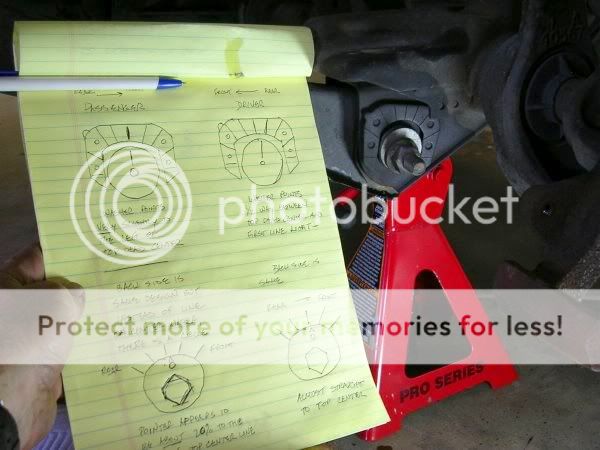
After removing all the steering linkage, I removed the disc brake calipers and then unbolted the four control arms at the frame.
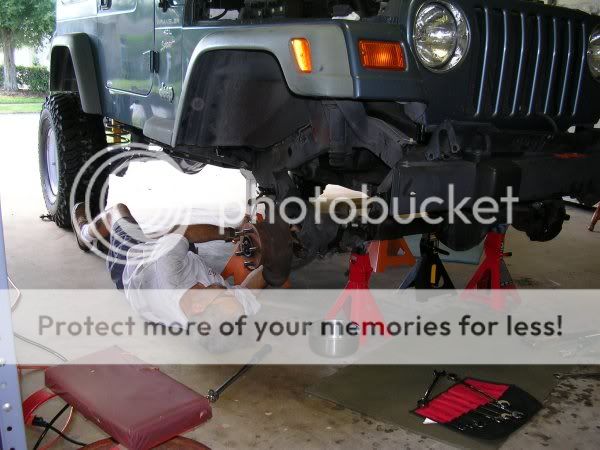
One of the other things I learned during this week in the garage was how to use the delayed timer on my digital camera....so I was able to "star" in some of the pictures....

I bought a salvage yard axle and took it apart and cleaned it up some and painted it....that story is in a earlier essay in case you want to go back and read about it. It has factory 4.10 gear ratio to match the rear rubicon dana 44. Just so this post can stand alone, I'll repeat that my swap axle is a from a '99 cherokee XJ with a four cylinder motor. The XJ front axle is a high pinion dana 30. The high pinion pumpkin puts the driveshaft on top of the axle centerline. This will help with some extra trail clearance and the ring gear is supposed to be a little stronger driven from the top. I went with this swap for those reasons and also because it saved me having to pay to regear my TJ axle. Many of the components are interchangable with my TJ axle. It had full cast brake rotors which are slightly different than my TJ rotors. It is from a wrecked jeep, so there is some risk that it will work without problems. It wasn't as pretty when I bought it.
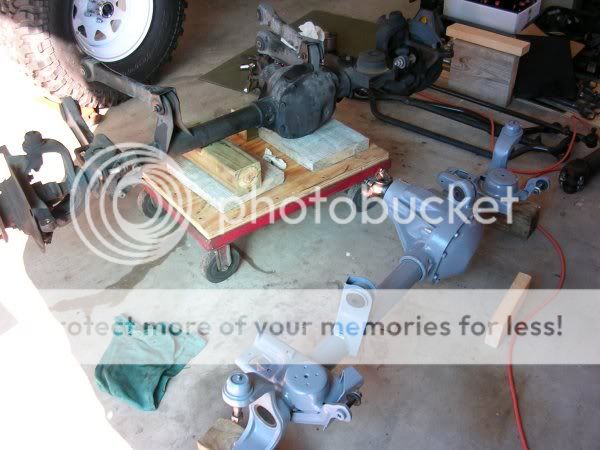
If you read any of the earlier stuff I posted, I have a growing pile of parts in the garage....some useful and some to be replaced.
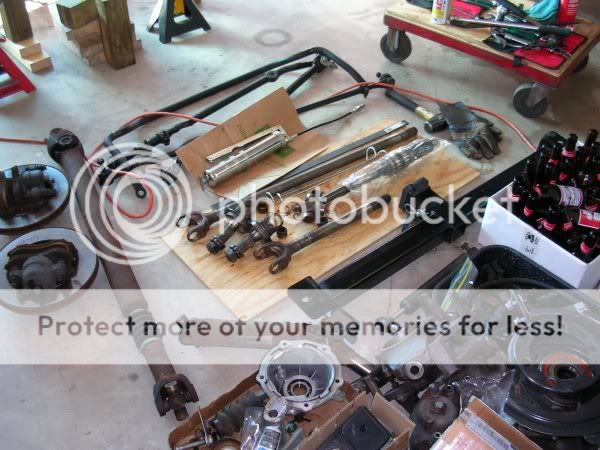
These are the adjustment bolts for the front lower control arms to set the caster angle. By rotating the bolt head, the shank will move along the elongated hole in the frame mount. Since the control arm bushing is a round hole, the axle has to rotate when you dial the bolt head. My rubicon express suspension lift kit will have adjustable arms, so I won't need these for the reinstall.
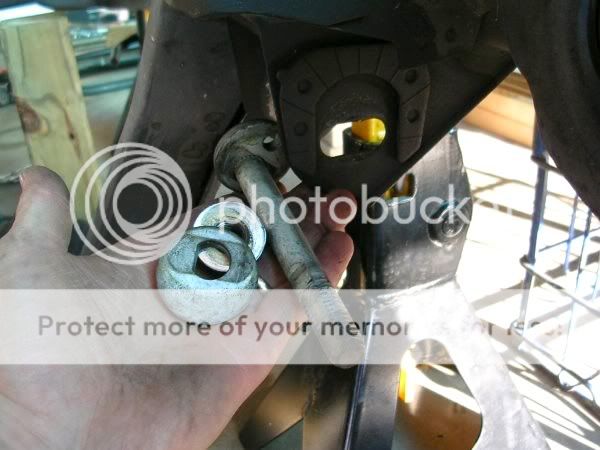
...more below....



